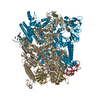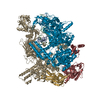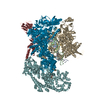+Search query
-Structure paper
| Title | RapA opens the RNA polymerase clamp to disrupt post-termination complexes and prevent cytotoxic R-loop formation. |
|---|---|
| Journal, issue, pages | Nat Struct Mol Biol, Vol. 32, Issue 4, Page 639-649, Year 2025 |
| Publish date | Jan 8, 2025 |
 Authors Authors | Joshua J Brewer / Koe Inlow / Rachel A Mooney / Barbara Bosch / Paul Dominic B Olinares / Leandro Pimentel Marcelino / Brian T Chait / Robert Landick / Jeff Gelles / Elizabeth A Campbell / Seth A Darst /  |
| PubMed Abstract | Following transcript release during intrinsic termination, Escherichia coli RNA polymerase (RNAP) often remains associated with DNA in a post-termination complex (PTC). RNAPs in PTCs are removed from ...Following transcript release during intrinsic termination, Escherichia coli RNA polymerase (RNAP) often remains associated with DNA in a post-termination complex (PTC). RNAPs in PTCs are removed from the DNA by the SWI2/SNF2 adenosine triphosphatase (ATPase) RapA. Here we determined PTC structures on negatively supercoiled DNA and with RapA engaged to dislodge the PTC. We found that core RNAP in the PTC can unwind DNA and initiate RNA synthesis but is prone to producing R-loops. Nucleotide binding to RapA triggers a conformational change that opens the RNAP clamp, allowing DNA in the RNAP cleft to reanneal and dissociate. We show that RapA helps to control cytotoxic R-loop formation in vivo, likely by disrupting PTCs. We suggest that analogous ATPases acting on PTCs to suppress transcriptional noise and R-loop formation may be widespread. These results hold importance for the bacterial transcription cycle and highlight a role for RapA in maintaining genome stability. |
 External links External links |  Nat Struct Mol Biol / Nat Struct Mol Biol /  PubMed:39779919 / PubMed:39779919 /  PubMed Central PubMed Central |
| Methods | EM (single particle) |
| Resolution | 3.62 - 4.69 Å |
| Structure data | EMDB-40922, PDB-8szw: EMDB-40930, PDB-8t00: EMDB-40931, PDB-8t02: EMDB-40943, PDB-8t0l: |
| Chemicals |  ChemComp-MG:  ChemComp-ZN:  ChemComp-ADP:  ChemComp-AF3: |
| Source |
|
 Keywords Keywords | TRANSCRIPTION/DNA / RNA polymerase / Negatively supercoiled DNA / Sigma-independent transcription / TRANSCRIPTION-DNA complex / TRANSCRIPTION / RapA / RNAP recycling / Sw2/Snf2 ATPase |
 Movie
Movie Controller
Controller Structure viewers
Structure viewers About Yorodumi Papers
About Yorodumi Papers












